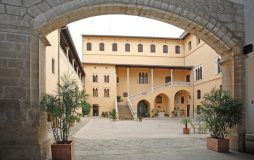La Safor
La Safor is an attractive region, divided between the coast and mountainous interior. The natural habitat of the high mountains of Mustalla, Safor, Agulles and Grossa is rich with vegetation, while the coastal border is made up of plains of wide groves, long beaches and also a dense urban area. The proximity of the three distinct landscapes which make up the region give La Safor the characteristic of an urban hive or a large dispersed city surrounded by greenery, which is dedicated to its major industry, the cultivation of oranges. Mountain summits are situated close by the sea, whilst orange groves are hidden between the slopes of the mountainsand wide horizons with long beachesare visible, all of which makes up the landscape of La Safor, an enduring spectacle throughout the year.
Gastronomy and events:
The local Mediterranean farms produce natural ingredients used in the preparation of some truly excellent food. In Gandia, you can enjoy the world-famous fideuà de Gandia, prepared with angel hair pasta cooked in a stock of langoustines, shrimp and monkfish, all cooked in the traditional Paella style pan. We also recommend that you try the fish and seafood on the coast of La Safor, particularly the eels and the gambaambbleda (a spinach and shrimp dish) in the coastal villages.Towns in the interior of the region specialize in sausages, rice dishes of every kind, figatells (a type of open sausage) and coques de dacsa (a rice cake). Alongsidethis, thesweets and cakes of region are also noteworthy. These are present throughout the whole region and are reminiscent of the sugar cane harvests.
From the Porrat de SantAntonito the Ball de la Bandera in Beniarjó (April), through to the festivals held in honor of the Virgin Mary (May, Real de Gandia), and les fogueres de Sant Joan (the bonfires of Saint John, held throughout the region in June), La Safor celebrates a whole host of festivals. The rutadelsporrats stands out, and is celebrated year round in various parts of the region. The porrats are pilgrimages which are celebrated traditionally by the people of the region to venerate their saints, and go on to become festivals with markets selling fruit, nuts, toys and much more. Currently, the popularity of the festivals is growing, due to the enjoyable and interesting events which run concurrently. The porrats currently celebrated are, in winter,SantAntoni (January) in Oliva andBenirredrà, SantBlai in Potries and SantMacià in Ròtova (February); also insummer, SantLlorenç and Crist de la Sang in Tavernes de la Valldigna, Santa Anna in Simat de la Valldigna and Sants de la Pedra in l’Alqueria de la Comtessa
Equally outstanding are the festivals of the Moors and Christians held in Oliva (the third weekend in July), the heritage festivals of the Mare de Déu del Rebollet (September 8), and, of course, la Fira I Festes de Gandia, celebrated in honor of Saint Francesco de Borja (late September and early October). Gandia, Oliva, Tavernes de la Valldigna, l’Alqueria de la ComtessaiXeraco, fill up with surprising Fallas monuments, for the festival of Saint Joseph (Sant Josep). These are Fallas festivals which, in the case of Gandia, have been declared of National Public Interest. Finally, and equally renowned for the lively celebrations held there, are the Easter festivals, which include emotional religious celebrations and incredible processions, such as those in Santa de Gandía, which also have been declared of National Tourist Interest.

